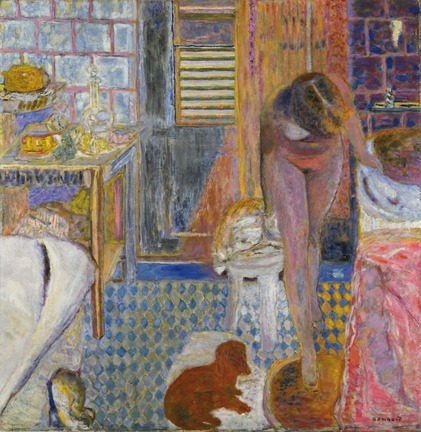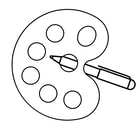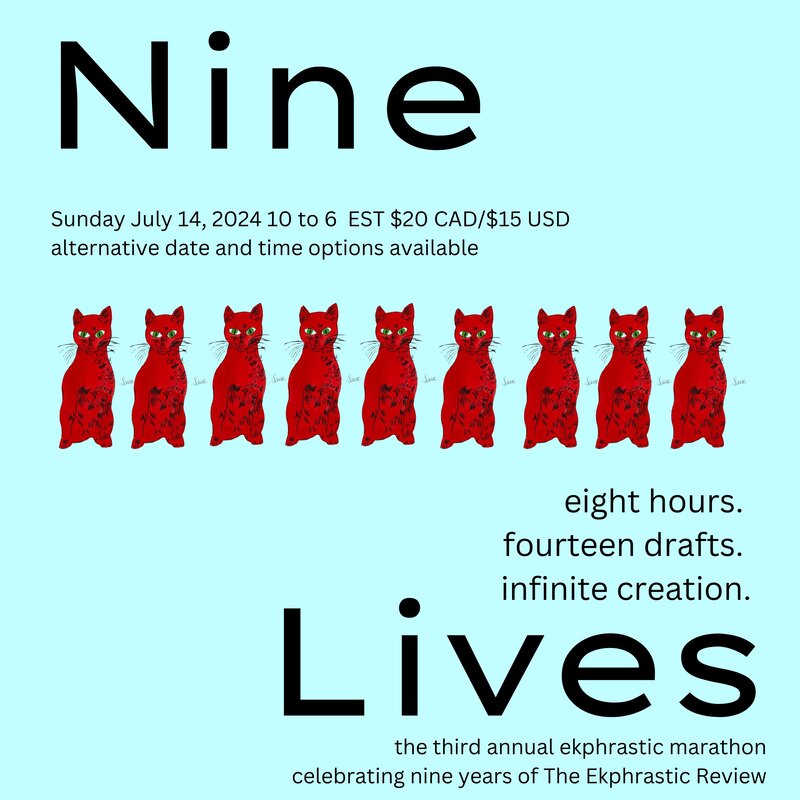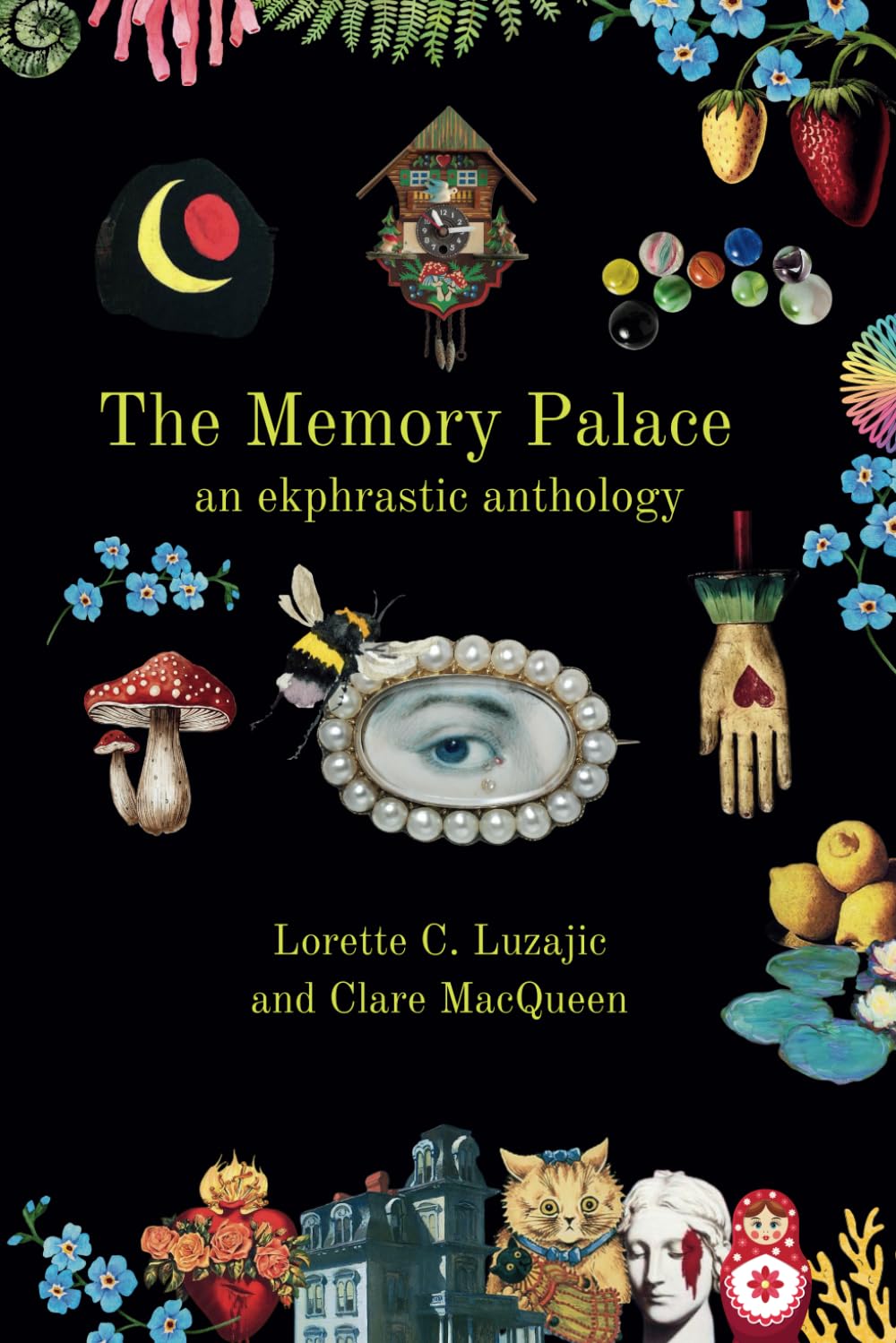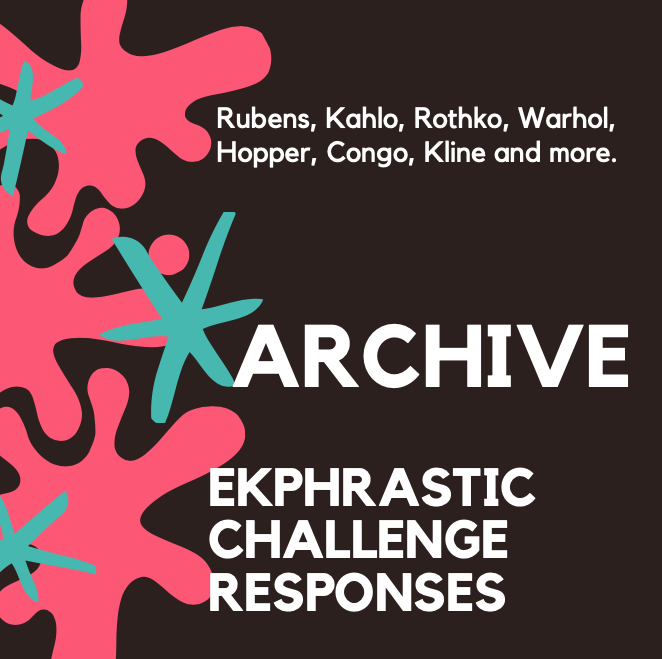|
Turning Colour Into Light Having not painted since the move from Boston to Berkeley move, I don’t know how to re-enter my work. Start at the beginning, I deduce, return to my first painting crush, my first artist love with whom I feel akin, French post impressionist painter-Pierre Bonnard. At Moe’s Book on Telegraph, I scan the Bonnard collection downstairs, pouring over the pages as I had done in art school. The borrowed library book, always propped up against the foot of my easel, open to a colour print that never came close to capturing the luminosity of the original, now splattered with turpentine drips in Bonnard hues. One of his still-lives could beckon me, with its shimmering colour, from across a museum. And it has. I pen poems. Flesh rainbow, an arching back across canvas like an opalescent bridge, connecting corporal form with the inner-envisioned world of ideas and spirit. Patterns and jutting edges, ambiguous red and vulva pink angle, pushing up through the corner, tightly arranged like sitar strings, a series of verticals, vibrating with colour. A bent knee, a foot extended in a marine like haze where the contours of a woman emerges from this deep Prussian blue. Leaning figure balanced on two violet legs, vanishes to a point where female figure poses beside a porcelain tub – brown in shape of dog against white. Images, hues like abalone shell reveal the shimmering interiors of intimacies, a life. This is the life I admire and desire, identifying with Bonnard’s aesthetics evident by his choice of subject matter- Marthe, his lover, in the bath, dressing at an open window, or sitting amidst a bowl of ripe fruit. His love of the intimate lives in me, too, and I yearn for the relationship they seem to share, bonded by these moments, forever captured in radiant pigment. A realization, would soon however, challenge my perception, change my course. It would pass so quietly, yet would shake my foundations. As I bend and twist at the edge of my bed, buckling my suede ankle boots, the worn post card of a Bonnard print hanging across the room above the light switch by the door, catches my eye. A revolution ensues. Everything must be reconfigured. My usual cafe will not do - too many distractions. At La Batou Evre, with its salmon pink linens and classical music wafting, a cafe where I am anonymous, a story will be conceived, gestated and birthed. Sculpting with words, at the La Batou Evre, I craft a story. Marthe and Pierre Marthe, the model and later wife of the French painter, Pierre Bonnard, was a sensitive woman. Easily offended by the vulgarity and harshness of Parisians and most people in general, she withdrew from social life. As a defense against this predisposition, she created a beautiful world in which only she and her husband lived. In fact it was such a place of refinement and simple, profound charm that Pierre surrendered willingly to her insistence that he remain home with her. He was happily seduced into her magical universe, content to render and record its moments and subtle movements. Occasionally he would sneak out to the café, the dog as a pretext, hoping to meet Matisse or some other friends. The other painters were not altogether understanding of his allegiance to Marthe and the severe restrictions on his freedom. Many gossiped that she was "unbalanced." To an artist, balance and beauty are synonymous and certainly, Pierre, a Libra, knew balance, and Marthe knew beauty – she lived in it and he lived for it. Their life together was like a brilliant gem, created and held in a masterfully designed ring, set upon a finger, perfectly contained unto itself. Their home, the centre of their life and backdrop to all events, was a cathedral of light. The dining room table was an altar, complete with goblets, wine and sacrificial flowers. The bath was Marthe’s sanctuary. With steam rising like incense, she submerged herself in warm baptismal waters, and meditation. This is where she found solace. Pierre’s painting was his favoured form of prayer- an extension of his own soul- stirrings and yearnings. So, like a devout parishioner, he portrayed her in devotion, ritually robing, anointing herself with fragrant oil, or setting the fruit offering on the table by the open window. He not only succeeded in capturing the quality of light around them, but as he created, Pierre had the wondrous ability to add to it. He was known to mutter as he worked- "It’s still colour, it is not yet light." In fact, there was so much luminosity in this place that even angels were attracted to linger. And they did. It happened at this time that I too was living in the world of spirits. It was late summer, when the air is heavy with the scent of tuberose, honeysuckle and jasmine and the garden is saturated with lustrous colour, boasting fuchsias, violets, oranges, buttery yellow, purble berry and red. Together they had morning coffee, only the sound of birds could be heard. Marthe would perform the daily bathing rites, a ceremony that could take hours, as Pierre followed with easel and pallet to worship by her side. He set up his new canvas which he had prepared the night before. This new painting seemed to compose itself with remarkable ease. Each colour mixed, resonated, shimmered and glowed like fiery embers as each stroke was gently laid against the other, seemingly effortless, yet executed with exacting intention. In spontaneous celebration of the day’s triumphant accomplishment, Pierre took his wife passionately in his arms and danced her to the feather bed in the next room. Tenderly, they made love in a rare moment of demonstrative affection and openness between them. The intensity of light was so great that late summer afternoon that I was somehow drawn down into their lives. There, for a brief moment, a beautiful few weeks, I was their union, their celestial collaboration, delicate tendrils of DNA creation. Their child. But, like the cut wild flowers on the nightstand, it wasn’t to last. It was revealed to me, shortly thereafter, that this was not my time to incarnate into human form- I was called back to the other side. I was deeply sad to leave Marthe. Although I had to abandon her corporeal body, I remained hovering near by as long as I could. Is it possible that the lost pregnancy only aggravated Marthe’s already sensitive nature, propelling her to retreat further into herself and into the rituals which comforted, soothed and sustained her? Perhaps too, Pierre’s seclusion was in part feeling responsible for her sorrow, or his own unexpressed grief and loss which kept him devoted. Perhaps he needed to connect to her and her pain in order to feel his. Sadly however, portraying his companion in those intimate scenes and exposed manner was the only way he knew to express his own vulnerability. Maybe it was really himself floating in the bathtub, expressionless, submerged in amber speckled indigo paint. Pierre accepted that this was closeness. A canvas always between them, keeping him emotionally exiled from the woman he yearned to know and, in some intrinsic way, from himself. So, despite all of Marthe’s efforts to avoid loneliness and isolation, she remained painfully alone, her partner never able to enter her world, only able to describe it in radiant detail. That which we most want is what we push away, and that which we are most determined to keep at bay, we invite in. They never spoke about the miscarriage, but I believe they both sensed my presence. I recognized myself in Pierre’s work as if he had depicted my very essence. Sometimes I appear as a vibrant violet surrounding Marthe like an aura. Other times I am the golden green ochre atmosphere in Pierre’s self-portraits. I was delighted to be recorded in their lives. Decades later, I was offered the opportunity to take earthly form. Yet, so strong were my impressions and memory of Pierre and Marthe that I awoke driven to construct a life of poetic duality, cherishing the simple pleasures, while finding the sacred in the mundane, the holy in the profane, and elevate it all. The curious revelation, sitting at the edge of my Berkeley bed, buckling my boots, was the sudden response to my direct view of a Bonnard’s print above the light switch- it was never Pierre’s aesthetic or sensual sensibilities that I had shared. But, rather those of Marthe! It was Marthe all along. How had I not see this before! As I write about the Bonnard’s, the picture of their relationship fans out before me. I cringe with embarrassment as if I have eavesdropped on a private moment, a door slightly ajar. Maybe these insights are real, or, perhaps, just the machinations of imagination. And would it matter? Such is the dynamic between fact and fiction. The metaphor, the story, is the essential, make believe. Believe and make. The intersection of art and life. My life informs my art, which informs my life in an ongoing conversation, leading me to examine my own biological parents and "this" life. Renee and Herman. Artist and Rabbi. With the same heat-sensitive lens that I viewed the Bonnards, I turn my gaze upon my blood parents. What is it to be the product of a rabbi and an artist? Like Herman Hesse’s Narcissus and Goldmund, my parents are the next puzzle pieces to understanding myself. I peek, peer into the obvious and come close to the mysteries. Sometimes I peer into the mysteries and come close to the obvious. I scrawl in the bathtub: "In this life, I must synthesize the fragmented existence of oppositions - love and freedom, reconciling desire and disappointment, creating, not just a painting, but a life- colourful, sublime, complex, balancing and transmuting tensions from the chaos, from the yearning- into light." "It’s still colour," says Pierre, "it is not yet light." As the water pours a steady stream from the faucet, I soak and float in the amniotic waters of my claw foot bath- sea salts and oils in musky, woodsy and floral fragrances by my side, remembering and reinventing my life, turning colour into light. Masha Savitz Masha Savitz has a BFA in Painting from Boston University a Masters Degree in Rabbinic Studies from the American University of Judaism. She wrote and directed the documentary RED REIGN, exposing forced organ harvesting in China from live Falun Gong practitioners based on the work of human rights lawyer and Noble Peace Prize nominee, David Matas. She contributes as an Arts and Entertainment journalist for Epoch Times.
0 Comments
Your comment will be posted after it is approved.
Leave a Reply. |
The Ekphrastic Review
COOKIES/PRIVACY
This site uses cookies to deliver your best navigation experience this time and next. Continuing here means you consent to cookies. Thank you. Join us on Facebook:
July 2024
|
